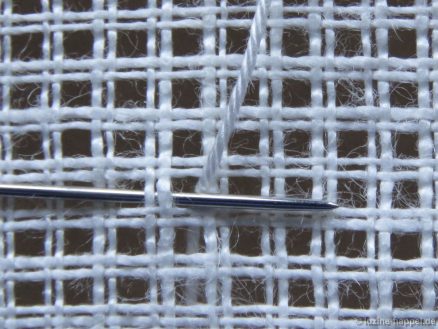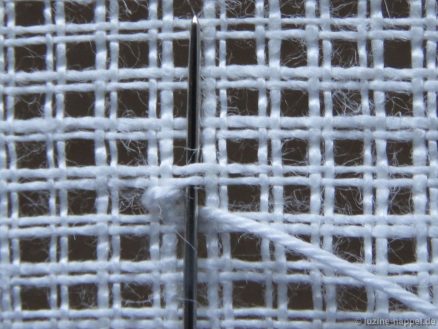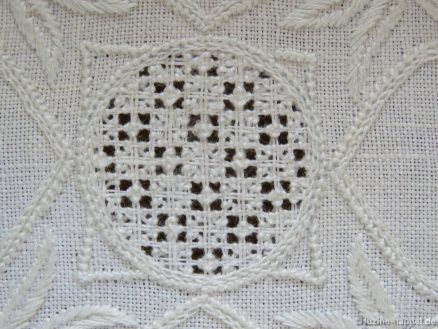category: openwork filling pattern without Cable stitch grid
stitches used: sections of Rose stitches and Four-Sided stitches
center: intersection of pairs of threads
As mentioned in my blog post Traditional Schwalm Whitework, I will now explain how to work a special pattern consisting of sections of Rose stitches and Four-Sided stitches in an openwork grid without Cable stitches. I first noticed such a pattern on a piece from 1804.
Starting at the center leave the two center threads, and then commence making the grid by always alternating between withdrawing and leaving two vertical threads. Do the same with the horizontal threads.

Bring the needle up in the hole at the bottom left of the center intersection (marked red).

Lay the thread in a loop to the top and left, insert the needle in the next hole to the left and bring it up again in the first hole. Pull the thread through.

*Cross over the working thread and under the upper pair of fabric threads, and bring the needle up in the next hole upward.

Again lay the thread in a loop to the top and left, insert the needle in the next hole to the left, and bring it up again in the previously used hole. Pull the thread through. The working thread is beneath the needle.

Lay a loop to the top right, insert the needle in the next hole upward, and bring it up again in the previously used hole.

Pull the thread through and turn the piece 90° counterclockwise*. Repeat the steps (*) until a square of 2 X 2 holes is filled with two sections of a Rose stitch each. The last stitch is worked in the bottom left hole of the square. From the last stitch, cross over the working thread

and insert the needle into the same hole.

On the back, slide the working thread under the former middle top stitch.

Looking at the next intersection above, bring the needle up in the top left hole to begin a Four-Sided stitch.

Cross over the pair of threads to the right, insert the needle, and bring it up diagonally in the bottom left hole.

Cross over the pair of threads to the right, insert the needle, and bring it up diagonally in the upper left hole.

Cross over the pair of threads downward, insert the needle, and bring it up diagonally in the upper right hole.

Cross over the pair of threads downward, insert the needle, and bring it up two holes up and one hole to the left. Start here with the next square of 2 X 2 holes to be filled with two sections of a Rose stitch each.

Work rows of alternating 2 X 2 squares and Four-Sided stitches.

Repeat the steps until the entire shape is filled.

For my first attempt, I used coton à broder No. 25, but it was too fine to fill the holes thoroughly. So, in the end I used coton à broder No. 16.

In the image above, the piece has not been boiled. After shrinking during the boiling process, the pattern will get a nice appearance with flat areas for the Rose-stitch-section squares and more prominent areas where the Four-Sided stitches are.

I will explain the counterpart – worked with the common pattern of Rose stitch squares in a Cable stitch grid – in a future article.





Beautiful pattern!
Wow